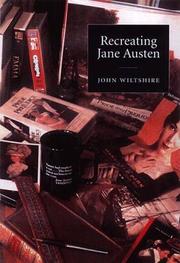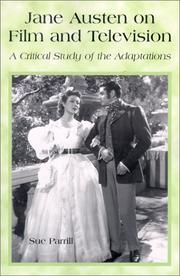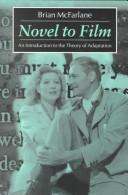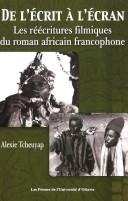| Listing 1 - 8 of 8 |
Sort by
|
Book
ISBN: 8899559198 8899559015 Year: 2018 Publisher: Torino : Edizioni Kaplan,
Abstract | Keywords | Export | Availability | Bookmark
 Loading...
Loading...Choose an application
- Reference Manager
- EndNote
- RefWorks (Direct export to RefWorks)
Tra i testi letterari di cui il cinema si è nutrito figurano anche tre romanzi di Pier Antonio Quarantotti Gambini: L’onda dell’ incrociatore, La calda vita e La rosa rossa che hanno dato vita, rispettivamente, a Les Régates de San Francisco (1960) di Claude Autant-Lara, La calda vita (1964) di Florestano Vancini e La rosa rossa (1973) di Franco Giraldi. Nella pur vasta bibliografia sui rapporti tra cinema e letteratura queste trasposizioni non sono mai state adeguatamente esplorate. Eppure si tratta di momenti storiografici di grande interesse, in particolare se assunti come specifici casi di studio della controversa relazione tra le due forme di espressione. Cercando di vedere quanto la poetica dello scrittore filtri sullo schermo, l’analisi si allarga dal confronto testuale al quadro storico di riferimento. Ognuno di tali casi, benché unico, si offre come occasione per ripensare la complessa dinamica dell’adattamento cinematografico di opere letterarie.
Film Radio Television --- adattamento cinematografico --- Quarantotti Gambino --- adaptation cinématographique --- film adaptation
Book
ISBN: 9783826044670 3826044673 Year: 2012 Volume: 1 Publisher: Würzburg: Königshausen und Neumann,
Abstract | Keywords | Export | Availability | Bookmark
 Loading...
Loading...Choose an application
- Reference Manager
- EndNote
- RefWorks (Direct export to RefWorks)
Lindgrens, Astrid, --- Littérature enfantine --- --Cinéma --- --Adaptation cinématographique --- --Children's literature, Swedish --- Film adaptations --- Film adaptations. --- History and criticism. --- Lindgren, Astrid, --- Children's literature, Swedish --- Cinéma --- Adaptation cinématographique --- Lindgrens, Astrid, 1907-2002
Book
ISBN: 9782840160212 2840160218 2821817916 2821826753 Year: 2008 Publisher: Paris: Presses universitaires de Paris Ouest,
Abstract | Keywords | Export | Availability | Bookmark
 Loading...
Loading...Choose an application
- Reference Manager
- EndNote
- RefWorks (Direct export to RefWorks)
Les premiers films Pathé aux écrans numériques, la marionnette a connu une vie filmique à éclipses, surgissant soudain et par éclats chez les plus grands, de Chaplin à Roberto Benigni, de Renoir et Bergman à Spielberg, Kitano et Tim Burton. Longtemps confinée dans l'animation, elle connaît aujourd'hui un spectaculaire retour sur les écrans du monde entier. Plus subversive que mélancolique, elle est cette créature double qui ne cesse de se libérer des liens qui l'assujettissent, dans le mutisme et l'humiliation, au Montreur ventriloque, au Père, au DeusiDiabolus ex machina. Elle est au cinéaste, à l'acteur, au spectateur ce que le Sphinx est à Œdipe : riche d'une vie sauvage, obscène, archaïque à laquelle il leur faut un temps se confronter. A travers ces corps de frontière en constantes mutations, les miroirs grossissants du cinéma nous renvoient les images libératrices d'une modernité en travail, entre retours à l'enfance, métamorphoses burlesques et passages vers d'inquiétantes ou sublimes étrangetés. Pour sortir de l'ombre la vie filmique des marionnettes, Laurence Schifano, Professeur d'Études cinématographiques à l'Université Paris 10, a rassemblé ici des historiens et des chercheurs dont les domaines de recherche se situent aux confins de la psychanalyse, de la littérature, du théâtre et du cinéma.
Puppets --- Animation (Cinematography) --- Marionnettes au cinéma --- Animation (Cinéma) --- In motion pictures --- Marionnettes au cinéma. --- Music, Dance, Drama & Film --- Film --- Marionnettes au cinéma --- Animation (Cinéma) --- Marionnettes au cinéma. --- marionnettes --- adaptation cinématographique --- cinéma d'animation --- Marionnettes --- Au cinéma

ISBN: 0521002826 9780521002820 0521802466 9780521802468 1107123070 0511153414 0511047843 0511119453 0511303432 0511484704 1280159391 9780511484704 0511012993 9780511012990 9780511119453 9780511047848 9780511153419 9781107123076 9780511303432 9781280159398 Year: 2001 Publisher: Cambridge New York Cambridge University Press
Abstract | Keywords | Export | Availability | Bookmark
 Loading...
Loading...Choose an application
- Reference Manager
- EndNote
- RefWorks (Direct export to RefWorks)
Recreating Jane Austen is a book for readers who know and love Austen's work. Stimulated by the recent crop of film and television versions of Austen's novels, John Wiltshire examines how they have been transposed and 'recreated' in another age and medium. Wiltshire illuminates the process of 'recreation' through the work of the psychoanalyst Donald Winnicott, and offers Jane Austen's own relation to Shakespeare as a suggestive parallel. Exploring the romantic impulse in Austenian biography, 'Jane Austen' as a commodity, and offering a re-interpretation of Pride and Prejudice, this book approaches the central question of the role Jane Austen plays in the contemporary cultural imagination.
Love stories, English --- Women and literature --- English romance fiction --- English fiction --- History and criticism --- History --- Austen, Jane, --- Ao-ssu-ting, --- Ao-ssu-ting, Chien, --- Aosiding, --- Aosiding, Jian, --- Āsṭin̲, Jēn̲, --- Austenová, Jane, --- Osten, Dzheĭn, --- Ostin, Dzhein, --- Остен, Джейн, --- Остен, Джейм, --- אוסטן, ג׳יין --- אוסטן, ג׳יין, --- أوستن، جين، --- Adaptations --- History and criticism. --- Appreciation. --- Criticism and interpretation. --- Lady, --- Author of Sense and Sensibility, --- Art appreciation. --- Femmes et littérature --- Histoires d'amour anglaises --- Literature --- adaptation cinématographique --- adaptation cinématographique. --- Histoire --- Histoire et critique. --- Adaptations. --- Austen, Jane --- Roman (genre littéraire) --- 2000 --- Adaptations cinématographiques. --- Appréciation. --- Critique et interprétation. --- Influence. --- Romance fiction, English --- Arts and Humanities --- Romance-language fiction, English

ISBN: 0786413492 9780786413492 Year: 2002 Publisher: Jefferson: McFarland,
Abstract | Keywords | Export | Availability | Bookmark
 Loading...
Loading...Choose an application
- Reference Manager
- EndNote
- RefWorks (Direct export to RefWorks)
This book traces the history of film and television adaptations of Jane Austen manuscripts, compares the adaptations to the manuscripts, compares the way different adaptations treat the novels, and analyzes the adaptations as examples of cinematic art. The first of seven chapters explains why the novels of Jane Austen have become a popular source of film and television adaptations. The following six chapters each cover one of Austen's novels: Sense and Sensibility, Pride and Prejudice, Emma, Mansfield Park, Persuasion, and Northanger Abbey. Each chapter begins with a summary of the main events of the novel. Then a history of the adaptations is presented followed by an analysis of the unique qualities of each adaptation, a comparison of these adaptations to each other and to the novels on which they are based, and a reflection of relevant film and literary criticism as it applies to the adaptations.
English fiction --- Film adaptations --- Television adaptations --- Bennet, Elizabeth (Fictitious character) --- Women in motion pictures. --- Love in motion pictures. --- Roman anglais --- Adaptations cinématographiques --- Adaptations télévisées --- Bennet, Elizabeth (Personnage fictif) --- Femmes au cinéma --- Amour au cinéma --- History and criticism. --- History and criticism --- Histoire et critique --- Hitoire et critique --- Austen, Jane, --- Film adaptations. --- Television adaptations. --- England --- Angleterre au cinéma --- In motion pictures. --- Amour au cinéma. --- Angleterre au cinéma. --- Femmes au cinéma. --- Film. --- Motion pictures. --- Romans. --- Verfilmingen. --- Verfilmung. --- Austen, Jane. --- Bennet, Elizabeth, --- Film and video adaptations. --- England. --- Littérature anglaise --- --Adaptation cinématographique --- --English fiction --- Love in motion pictures --- In motion pictures --- Adaptation cinématographique --- English fiction - Television adaptations --- English fiction - Film adaptations --- Film adaptations - History and criticism --- Television adaptations - History and criticism --- Austen, Jane, - 1775-1817 - Film adaptations --- Austen, Jane, - 1775-1817 - Television adaptations --- Austen, Jane, 1775-1817 --- England - In motion pictures --- Austen, Jane, - 1775-1817

ISBN: 0198711506 0198711514 9780198711513 9780198711506 Year: 1996 Publisher: Oxford: Clarendon,
Abstract | Keywords | Export | Availability | Bookmark
 Loading...
Loading...Choose an application
- Reference Manager
- EndNote
- RefWorks (Direct export to RefWorks)
'It wasn't as good as the book' - this is the response to many a film adaptation, and even the starting point of many film reviews. Novel to Film is the first sytematic theoretical account of the process by which the great (and not so great) works of literature are transformed into the good, bad (sometimes ugly) but always distinctive medium of cinema. Drawing upon recent relevant literary and film theory, the book provides careful analysis of the theory and practice of metamorphosis. The Scarlet Letter, Random Harvest, Great Expectations, Daisy Miller and Cape Fear provide case studies which represent a range of fiction and cinematic practice.
Literary semiotics --- Film --- Film adaptations. --- Adaptations cinématographiques --- Adaptation cinématographique --- --Cinéma --- --Littérature --- --Film adaptations --- 791.43 --- Filmkunst. Films. Cinema --- 791.43 Filmkunst. Films. Cinema --- Adaptations cinématographiques --- Film adaptations --- Adaptations, Film --- Books, Filmed --- Filmed books --- Films from books --- Literature --- Motion picture adaptations --- Motion pictures --- Adaptations --- Cinéma --- Littérature --- HAWTHORNE (NATHANIEL), 1804-1864 --- HILTON (JAMES) --- DICKENS (CHARLES), 1812-1870 --- JAMES (HENRY), 1843-1916 --- MacDONALD (JOHN) --- CINEMA ET LITTERATURE --- ADAPTATIONS CINEMATOGRAPHIQUES ET TELEVISEES --- THE SCARLET LETTER --- RANDOM HARVEST --- GREAT EXPECTATIONS --- DAISY MILLER --- CAPE FEAR
Book
ISBN: 9782875743497 287574349X Year: 2016 Volume: 8 Publisher: Bruxelles: Peter Lang,
Abstract | Keywords | Export | Availability | Bookmark
 Loading...
Loading...Choose an application
- Reference Manager
- EndNote
- RefWorks (Direct export to RefWorks)
Cet ouvrage porte sur le cas concret de Maurice Maeterlinck comme auteur adapté à l'époque du cinéma muet. Inspiré de la théorie de Pierre Bourdieu, il propose de renouveler la problématique de l?adaptation cinématographique en prenant pour point de départ l?auteur agissant dans plusieurs champs et étant agi par ceux-ci. Dans les années dix et vingt, Maeterlinck occupe des positions contrastées : consacré en littérature, peu ou pas reconnu au cinéma. Cet écart suscite un triple questionnement, sur l'entrée de l'auteur dans le champ cinématographique, sur les stratégies qu'il transpose d'un domaine à l'autre, enfin sur l'ajustement des stratégies aux états successifs du cinéma. Centré sur le contexte de production des œuvres, l?ouvrage ne néglige pas leur dimension esthétique. Il met en évidence des sources premières rarement sollicitées : les films Monna Vanna (Ambrosio, 1914?1916), Pelléas et Mélisande (Éclair, 1915) et The Blue Bird (Paramount, 1918). L'analyse esthétique révèle la manière dont le cinéma reprend des éléments théâtraux et se les réapproprie, ou encore dans quelle mesure les œuvres adaptées oscillent entre les différents pôles de production et se stabilisent dans la zone de grande production de qualité
Cinéma --- Histoire et critique --- Maeterlinck, Maurice, --- Critique et interprétation --- Au cinéma --- Motion pictures and literature --- Silent films --- Film adaptations --- Belgian literature --- Cinéma et littérature --- Films muets --- Adaptations cinématographiques --- Littérature belge --- History and criticism --- Maeterlinck, Maurice --- Criticism and interpretation. --- Film adaptations. --- Cinéma et littérature --- Adaptations cinématographiques --- Littérature belge --- Histoire et critique. --- History and criticism. --- Critique et interprétation. --- Au cinéma. --- 20e siècle --- Adaptation cinématographique --- Théâtre --- Pelléas et Mélisande --- Cinéma muet --- Monna Vanna --- L'Oiseau bleu --- Bourdieu, Pierre

ISBN: 2760326942 2760315754 2760305805 9782760326941 9782760315754 Year: 2005 Publisher: Les Presses de l’Université d’Ottawa | University of Ottawa Press
Abstract | Keywords | Export | Availability | Bookmark
 Loading...
Loading...Choose an application
- Reference Manager
- EndNote
- RefWorks (Direct export to RefWorks)
De l'écrit à l'écran est le premier ouvrage qui aborde la question de la réécriture filmique du roman africain francophone. Il se sert de la sémiologie de l'image, de la poétique et des théories post-coloniales pour définir les enjeux théoriques, idéologiques et sémantiques régissant le passage des textes littéraires au cinéma. Il identifie des paramètres importants dans la poétique de l'écriture et montre le rôle de l'acte créateur dans l'altérité du texte dérivé, filmique, par rapport au texte de départ, littéraire. De ce fait, il formule des propositions novatrices par rapport aux inte
Motion pictures --- Motion pictures and literature --- African literature (French) --- Film adaptations. --- Adaptations, Film --- Books, Filmed --- Filmed books --- Films from books --- Literature --- Motion picture adaptations --- French literature --- Literature and motion pictures --- Moving-pictures and literature --- Cinema --- Feature films --- Films --- Movies --- Moving-pictures --- Audio-visual materials --- Mass media --- Performing arts --- Film adaptations --- Adaptations --- African authors --- History and criticism --- Recit filmique. --- Cinema et litterature --- Litterature africaine (française) --- Adaptations cinematographiques. --- Film and video adaptations. --- Adaptations cinematographiques et televisees. --- roman africain --- adaptation cinématographique --- littérature --- récit filmique --- Français (langue) --- cinéma
| Listing 1 - 8 of 8 |
Sort by
|

 Search
Search Feedback
Feedback About UniCat
About UniCat  Help
Help News
News